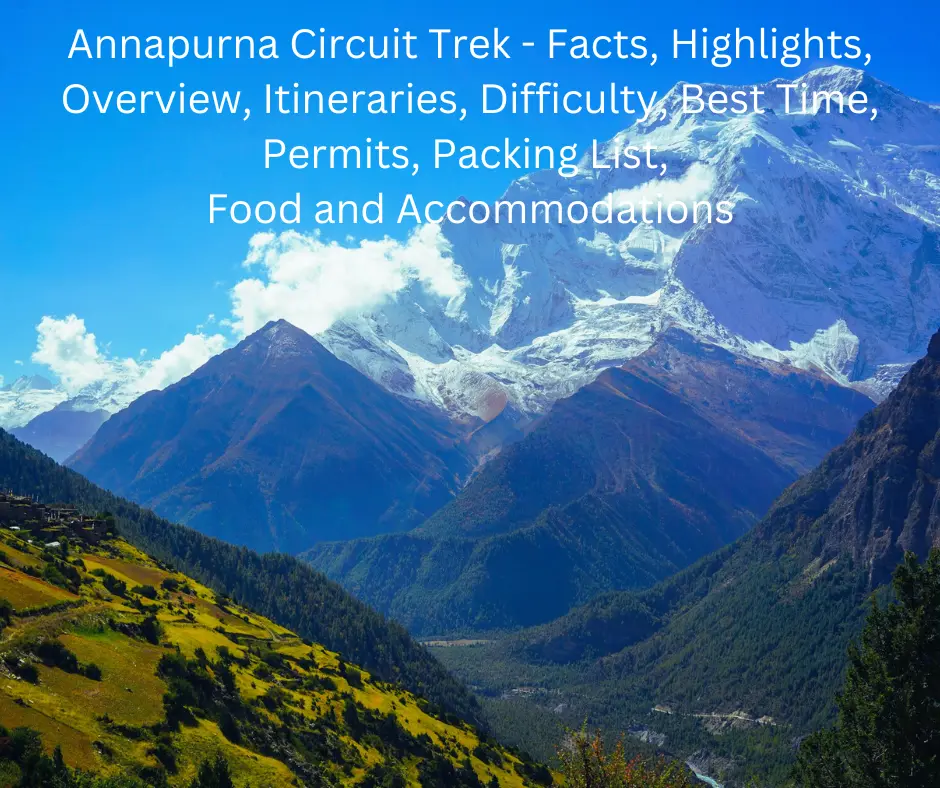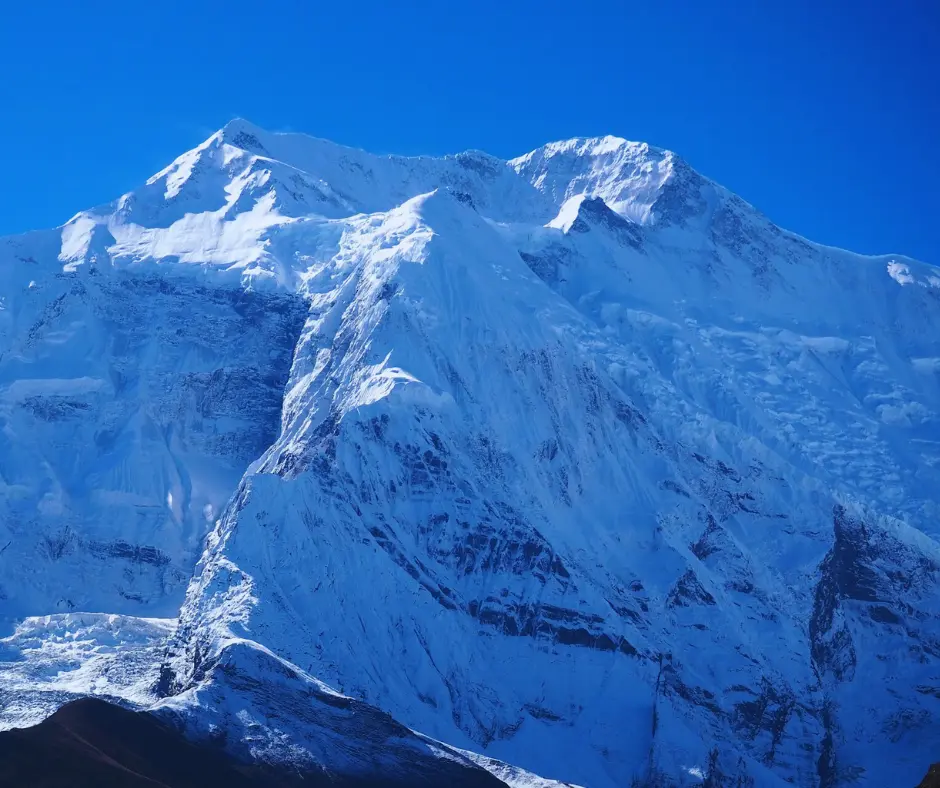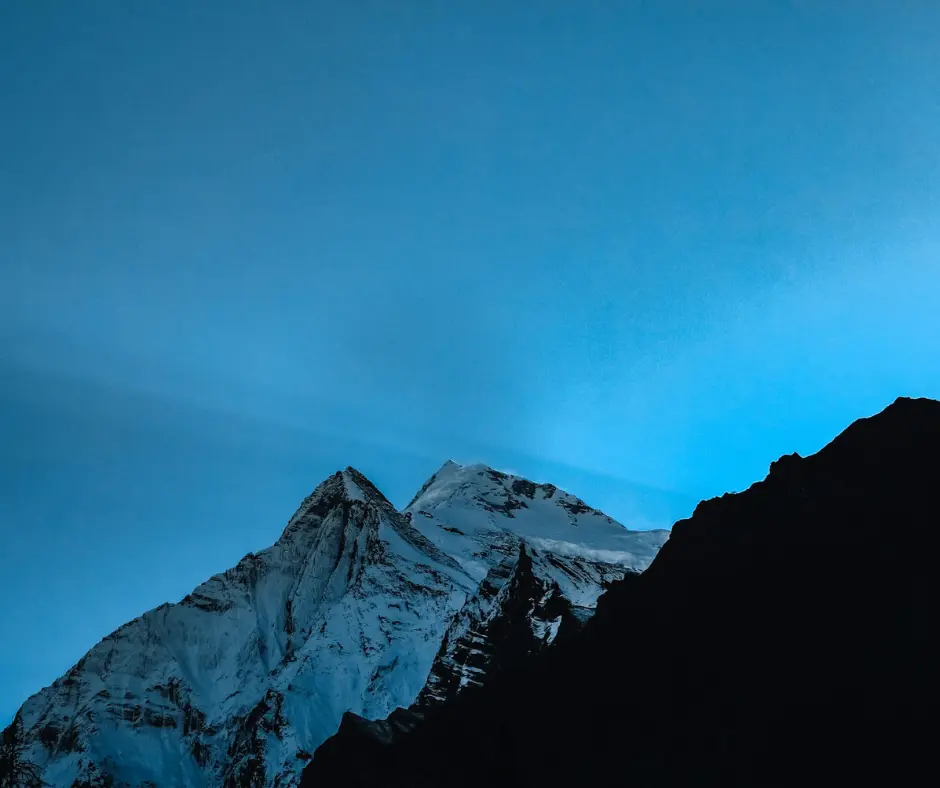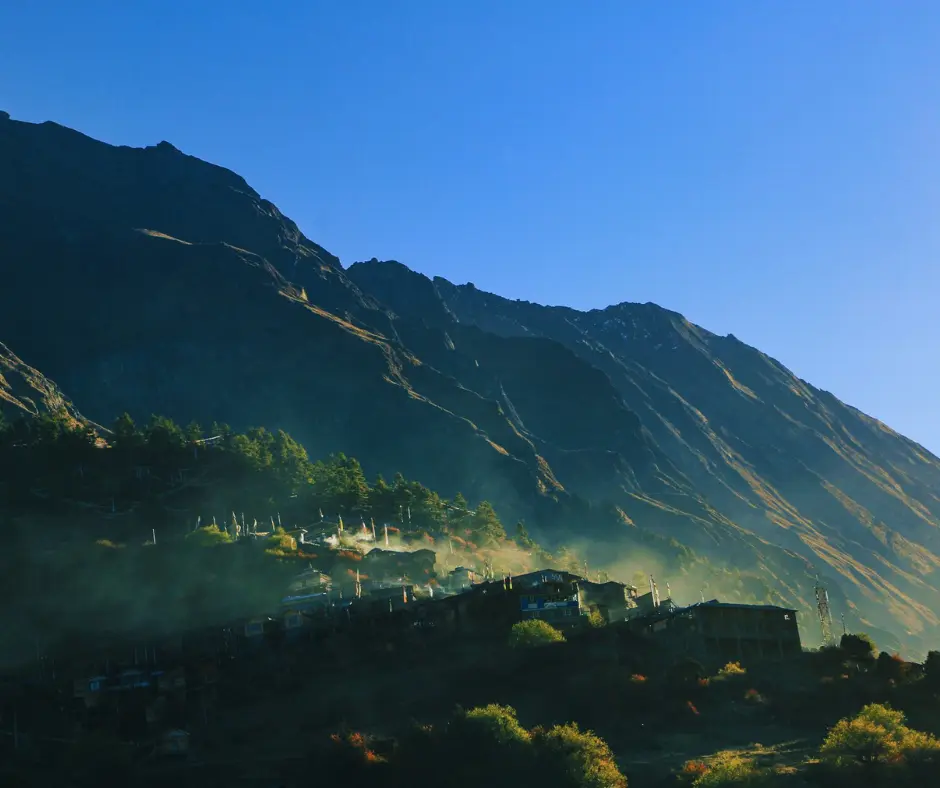Annapurna Circuit Trek - Facts, Highlights, Overview, Itineraries, Difficulty, Best Time, Permits and Packing List
Page Contents
Toggle
The Annapurna Circuit trek is considered one of the best long-distance treks in the world located in the Annapurna Region of Nepal. The trek lies within the Annapurna Conservation Area (ACA), which is the largest protected area in Nepal. This journey takes you through a wide range of landscapes, from lush subtropical forests and terraced fields to the arid highlands of the Tibetan Plateau.
The length of the Annapurna Circuit trek route varies between 160–230 km (100-145 mi), depending on where transportation is used and where the trek is ended. Nowadays, the continous road construction has shortened the trail threatening its reputation and its future as a classic trek in the world.
This trek crosses two different river valleys and encircles the Annapurna mountain ranges. Thorong La pass (5, 416m / 17,769 ft) is the highest point on the trek reaching the edge of the Tibetan plateau.
You can witness several mountain ranges throughout the circuit trek incluing Manaslu (an 8,000-plus meter peak), Langtang Himal, Annapurna II and IV, Annapurna III, Gangapurna, Annapurna I and Dhaulagiri. You will also pass through the world's deepest gorge - Kali Gandaki George. The gorge separates Mount Dhaulagiri (8,167 m or 26,795 ft) on the west and Mount Annapurna (8,091 m or 26,545 ft) on the east.
The 11 days Annapurna Circuit trekking begins at Besisahar, gradually ascending through villages like Chamje and Manang, with acclimatization stops. After crossing the Thorong La Pass, the route descends to Muktinath and ends in Jomsom or Pokhara, depending on your chosen itinerary.
Like most of the Annapurna region treks in Nepal, the best times to go on the Annapurna Circuit are during the spring (March to May) and autumn (September to November). These months offer stable weather, clear skies, and pleasant trekking conditions. Although the difficulty level of the trek is considered challenging due to its length, high altitudes, and the demanding Thorong La Pass, it's essential for every trekkers to select the best season to trek. Good physical fitness and prior trekking experience are recommended.
You will need the Annapurna Conservation Area Permit (ACAP) and the Trekkers' Information Management System (TIMS) card for the Annapurna Circuit Trekking. Along with the trek permits, pack warm and breathable clothing for varying temperatures, as well as sturdy trekking boots and a good-quality sleeping bag. Essential items include a waterproof jacket, trekking poles, sunscreen, a headlamp, and a first-aid kit.
Trek Facts
- Difficulty: Challenging
- Max Elevation: 5,416 m
- Best Time: Mar, Apr, May, Sept, Oct & Nov
- Transportation: By Road (Private / Public Vehicle) and By Flight
- Trek Duration: 11 Days
- Accommodation: Hotel / Teahouse
- Per Day Walking: 4 - 6 Hours
- Trek start and End Point: Kathmandu
Trek Highlights
- Spectacular Mountain views Annapurna, Thorung Peak, Nilgiri, Chulu West, Chulu East, Tukuche Peak, Dhaulagiri, Lamjung Himal, Annapurna II, and Annapurna IV.
- Visit the Shree Muktinath temple, a sacred place for Hindus and Buddhists.
- Cross Challenging Thorong La Pass at 5,416 meters / 17769 ft.
- Witness Magnificent lakes, glaciers, deep gorges, and stunning waterfalls
- Walk through the woods of oak, rhododendron forests, and rice fields.
- Visit the largest Monastery of Manang - Braga Monastery.
- Visit Natural hot springs at Tatopani where you can choose to take a dip and relax.
- Explore beautiful Jomsom - the headquarters of Manang.
Trek Overview

The trek begins with a drive from Kathmandu to Bhulbhule, west of Kathmandu . Bhulbhule can be reached after a 7-8 hour drive from Kathmandu. The route follows the Marsyandghi River Valley, taking you through Jagat, Dharapani, Chame, and Pisang.
On the sixth day, you will reach Manang where you will acclimatize. After acclimatizing at Manang, you continue the trek and head to Yak Kharka, and on the next day, you will hike up to Thorong Phedi.
You will leave Thorong Phedi on the 10th day and pass through the highest elevation of the trek Thorong La Pass (5,416m/17,769ft) and trek towards Muktinath. Throng La Pass (5416m) connects Manang village and Muktinath Temple.
After spending an overnight night in Muktinath Village you continue the hike to Jomsom, the headquarters of Mustang Village.
The Next day early morning you fly from Manang to Pokhara with magnificent panoramic views of the Annapurna Himalaya Range.
After reaching Pokhara, you could visit Fewa Lake and explore the city. Pokhara is the second-biggest city in Nepal and is a natural beauty. Green Valley Nepal Treks offers other different trekking packages in the Annapurna Region, similar to Annapurna Circuit Trek.
11 Days Annapurna Circuit Trek With Tilicho Lake Itineraries
Day 1: Drive from Kathmandu to Bhulbhule (845m / 2,815ft)
Driving hours: (200km / 124 miles): 7-8 hrs
The first day of the Annapurna Circuit Trek starts from Kathmandu to Bhulbhule. The route takes you along the picturesque Trishuli River to Besisahar, and finally to Bhulbhule.
Bhulbhule lies by the side of the Marsyangdi River. At Bhulbhule, you register your trek permits at the check post.
Day 2: Trek from Bhulbhule (845m / 2,815ft) to Jagat (1,300m / 4,265ft)
Trek Distance: 16km / 9.9miles
Highest Altitude: 1,300m / 4,265ft
Trek Duration: 5 hrs
The route from Bhulbhule follows a path through the jungle and terraced fields upriver, along the Marsyangdi river. You pass through several rural settlements and more farmlands to gradually reach Jagat, a former trading post.
Day 3: Trek from Jagat (1,300m / 4,265ft) to Dharapani(1,860m / 6,200ft)
Trek Distance: 15km / 9.3miles
Highest Altitude: 1,860m / 6,200ft
Trek Duration: 5 hrs
You begin your 3rd day of the trek following the Marsyangdi River, and after a steep climb, you reach Tal village in the Manang region. You can see several waterfalls forming a river by the sandy beaches.
You will hike through the barley, and potato fields and reach Kodo. Kodo is one of the biggest villages in the Manang Valley. Moving forward, you cross a suspension bridge and reach Dharapani, the destination for this day.
Day 4: Trek from Dharapani (1,860m / 6,200ft) to Chame (2,610m /8,890ft)
Trek Distance: 15.5km / 9.6miles
Highest Altitude: 2,610m / 8,890ft
Trek Duration: 6 hrs
You leave Dharapani and follow the trails through the pine, fir, and oak forests along the Marsyangdi River to reach Chame - the district headquarters of Manang district.
As you reach Chame, you will witness green forests and remarkable views of Lamjung Himal, Annapurna II, and Annapurna IV (7,525m).
Day 5: Trek from Chame (2,610m / 8,890ft) to Pisang (3,300m / 10,826ft)
Trek Distance: 13.2km / 8.2miles
Highest Altitude: 3,115m/10,200ft
Trek Duration: 5 - 6 hrs
Today, you walk through a steep and narrow valley to have your first view of a massive rock wall - the Paungda Danda Rock, considered very sacred by the locals. The Paungda Danda Rock is a curved rock face rising 1500 m from the Marshyandi River.
From the trails, you can witness views of Annapurna II in the south and Pisang Peak in the northeast.
Then the path descends taking you to the Pisang village, where you will spend your night.
Day 6: Trek from Pisang (3,115m / 10,200ft) to Manang (3,540m / 11,300ft)
Trek Distance: 17km / 10.6miles
Highest Altitude: 3,540m / 11,300ft
Trek Duration: 5 - 6 hrs
On the sixth day, you will trek on the upper trails through Upper Pisang via Geru, from where you can witness the north face of Annapurna II, III, IV, Gangapurna, Tilicho, and Pisang Peak.
This trail goes through the Tibetan settlements, where you can explore Buddhist culture. We will visit Barge Monastery, the largest monastery in Manang.
You will find many monasteries and finally reach Manang Bazaar.
Day 7: Rest and Acclimatization day at Manang (3,519m / 11,545ft)
You will be acclimatizing and exploring on this day.
You will visit Gangapurna & Ice Lakes, and spend the rest of the day witnessing the magnificent views of Annapurna III, Tilicho, Pisang, and Chulu Peaks.
You can also visit the Himalayan Rescue Association in Vraja village, where you can learn about acute mountain sickness, its symptoms, and prevention methods.
Day 8: Trek from Manang (3,540m / 11,300ft) to Yak Kharka (4,050m / 14,275ft)
Trek Distance: 9.4km / 5.8miles
Highest Altitude: 4,050m / 14,275ft
Trek Duration: 3-4 hrs
After spending a day at Manang and acclimatizing, you will trek to Yak Kharka.
You will be passing through several pastures and juniper forests. As your trek continues, you will pass through a small village called Gunsan. You will also get to see yak and horse pastures along the way.
After crossing a small river on a wooden bridge, you make your way up the spectacular valley of Yak Kharka.
Day 9: Trek from Yak Kharka (4,050m/ 14,275ft) to Thorong Phedi (4,525m / 14,525ft)
Trek Distance: 8.5km / 5.2miles
Highest Altitude: 4,525m / 14,525ft
Trek Duration: 4-5 hrs
Today you head to the foot of Thorong La pass, Thorong Phedi. From Yak Kharka, you will climb up to a ridge, then head down and cross the Marsyangdi River on a wooden bridge. After climbing up the mountain, you follow a narrow path across a slope and descend to Thorong Phedi. The uninhabited, rugged terrain is much different than the lush lowlands that you passed on the way up during the starting phase of the trek.
Day 10: Trek from Thorong Phedi (4,525m / 14,525ft) to Muktinath Temple (3,760m / 12,623ft) via Thorong La High Pass (5,416m / 17,756ft)
Trek Distance: 15.6km / 9.6miles
Highest Altitude: 5,416m /17,756ft
Trek Duration: 9 hrs
Today is the most challenging day of the trek as you will pass through Thorong La Pass (5,416 m/17,756 ft), the highest elevation on the trek. Today, you will trek from Thorong Phedi (4,525m/14,525ft) to Muktinath Temple (3,760m/12,623ft) via Thorung La pass.
You start early in the morning and push yourself through the icy air and high altitude to Thorong La Pass. You will see a panoramic view of Himalayan peaks including the Annapurna range.
After descending you reach Muktinath temple - a sacred place for Hindus and Buddhists. The Buddhists call Muktinath - Chumig Gyatsa, which in Tibetan means Hundred Waters. Muktinath Temple is known for 108 stone sprouts and the eternal flame that has been burning there for more than 2,000 years.
Crossing Thorong La Pass and visiting Muktinath Temple is one of the reasons to choose Annapurna Circuit Trek.
Day 11: Drive from Muktinath (3,760m / 12,623ft) to Jomsom
Driving hours (113km / 70miles ): 6-7 hrs
Highest Altitude: 3,760m / 12,623ft
You will visit Muktinath Temple and drive to Jomsom through Jharkot Village, Kagbeni, and Ekle Bhatti, which serves as the administrative center for the Mustang District.
One of the windiest valleys in Nepal is Jomsom.
Day 10:Take Flight from Jomsom (2720m) to Pokhara (822m)
Jomsom is the primary transition point for trips to Muktinath and Upper Mustang. This will be your last trekking day of the Annapurna Circuit Trekking. You can observe the panoramic vistas of the Annapurna Himalaya Range throughout the flight.
The flight time to Pokhara is between 30 and 40 minutes.
Day 11:Drive or Flight from Pokhara (822m) to Kathmandu (1400m)
This is the last day of your Annapurna Circuit Trek Itinerary. You can take a drive or flight from Pokhara to Kathmandu.
How Difficult is the Annapurna Circuit Trek?

The 11-day Annapurna Circuit Trek is challenging in the Annapurna region.
The trekking takes place at lower altitudes below 3000 m from Bhulbhule to Chame for five days and consists of five to six hours of walking a day. Days tend to have early starts and afternoon finishes, with most of the days involving five to seven hours of hike.
However, the most challenging part of your trekking takes you from Thorong Phedi to Muktinath Temple (3,760m), and we will be crossing the highest elevation of the trek - Thorong La Pass (5,416m). This is a mountain journey, and the routes involve long climbs, steep descents, and straightforward roads.
Past trekking experience would be an added advantage, but no technical experience and skills are necessary. Although the trek is challenging, anyone with a good level of physical fitness can complete the trek. Exercising cardiovascular and strength training regularly for a couple of weeks before the trip increases your stamina and allows you to enjoy the trek to its fullest.
Understanding the difficulty level of the Annapurna Circuit is crucial before embarking on this journey. For a complete breakdown, read my article on Annapurna Circuit Trek Difficulty.
How to Tackle the Difficulty of Annapurna Circuit Trekking?
Preparing for the Annapurna Circuit Trek involves physical and mental training and readiness.
Physically, build cardiovascular fitness, strength, and hiking endurance through regular exercises like running, strength training, and practice hikes. Additionally, incorporating flexibility and balance exercises such as yoga can enhance your overall fitness.
Practice stress-reducing techniques such as meditation, deep breathing exercises, or mindfulness as a part of mental training. Maintain a positive mindset and be prepared for unexpected challenges.
Preparing for both physical and mental fatigue can help you complete the trek.
Embarking on the Annapurna Circuit is an adventure of a lifetime. To ensure you're fully prepared and make the most of your journey, don’t miss my essential tips to prepare for Annapurna Circuit Trek.
When is the Best Time For the Annapurna Circuit Trekking?
The best time for the Annapurna Circuit trek is the Autumn (September, October, November) and Spring (March, April, May) seasons. During these seasons skies are clear with stable climate and weather conditions.
Spring (March-May) - The weather is mild, the rainfall is low, and the trekking conditions are perfect in the Spring Season.
Autumn (September, October, November) - Moderate temperatures, clear sky, mild wind, and low precipitation make autumn a perfect time for trekking to Annapurna Circuit. You get an unobstructed mountain views during this time.
With the right preparation, the Annapurna Circuit can be an unforgettable adventure. Make sure you embark during the ideal season by checking my guide on the best time for Annapurna Circuit Trek.
What are the Permits Required For the Annapurna Circuit Trek?
You need 2 permits to trek Annapurna Base Camp – Trekkers Information Management System (TIMS) and Annapurna Conservation Area Permit (ACAP).
TIMS Card:
TIMS card is for the safety of the trekkers and visitors. TIMS card can be obtained from the TAAN Secretariat in Maligaun, TAAN TIMS Counter in Saatghumti, Thamel, and TAAN Pokhara Secretariat in Pokhara.
The costs of TIMS card are as follows:
For SAARC citizens NPR 1000 per person.
For foreign nationals NPR 2000 per person.
TIMS card is not required for Nepali citizens.
Annapurna Conservation Area Permit (ACAP):
ACAP is another permit required in the entire Annapurna region. ACAP permits can be obtained in the Tourism Board of Nepal and also in Pokhara.
The Costs of ACAP are as follows:
For SAARC citizens NPR 1000 per person.
For foreign citizens NPR 2000 per person.
For Nepali citizens NPR 100 per person.
Free for a child below 10 years as a child discount.
What to Pack for the Annapurna Circuit Trek?
The Annapurna Circuit Trek demands smart packing due to its diverse terrain and changing climates. Your packing list should include essential gear like sturdy trekking boots, moisture-wicking clothing for layering, a warm sleeping bag, and a quality backpack.
Cold weather gear, including a down jacket and thermal layers, is crucial for high-altitude sections. Don't forget trekking poles, a headlamp, and personal items like sunscreen, a first aid kit, and a water purifier. Packing light but efficient ensures you're prepared for both the challenging conditions and the breathtaking scenery along the Annapurna Circuit.
Depending on the season, you need to adjust the things you bring to the trek. We advise you to bring only the essential things. Here is a list for you to consider while packing.
Headwear
- Sun hat or brimmed hat
- Winter hat or insulating hat, or a wide-brimmed hat
- Neck gaiter / Microfleece buff
Handwear
- Lightweight thinner gloves
- Heavyweight winter gloves
Bodywear
- Hiking shirts.
- Thermal inner layer / Baselayer set.
- Hooded waterproof jacket.
- Fleece jacket.
- Lightweight cotton pants.
- T-Shirt (bring lightweight wool).
- Down jacket.
- Hikinh pants
- Hiking sorts
Footwear
- Hiking Boots.
- Casual shoes or slippers for a teahouse stay.
- Thick wool socks.
- Inner socks.
Gear and Additional Accessories
- Backpack with Rain Cover.
- Trekking Poles.
- Sleeping Bag (If you are trekking in Winter Season).
- Rain Coat.
- Water Bottles.
- Thermal Flask.
- Phone Charger.
- Power Bank.
- Camera and Binoculars (Optional).
- Head Torch with Extra Batteries.
- UV protection sunglasses.
- Crampons (If you are trekking in Winter Season).
- Games and Books (Optional).
Toiletries
- Bio-degradable Towel.
- Toilet paper.
- Wet Wipes.
- Biodegradable soap.
- Deodorant.
- Toothbrush and Toothpaste.
- Nail Clipper.
Foods on the 11 Days Annapurna Circuit Trek
The food options are excellent during the 11 Days Annapurna Circuit Trek. The menu option consists of traditional local, Asian, and Western cuisine, but as you go up, the menu gets shorter.
Liquids like green tea, lemon tea, hot lemon, ginger tea, garlic soup (must), and fresh vegetables will help you stay nutritious and healthy throughout the trek.
Try popular nepali and healthy dishes like dal (lentils), bhat (rice), tarkari (curry), momos (dumplings), boiled potatoes with chili sauce, Sherpa stew, and Chow Mein (noodles). Avoid non-veg items, dairy products, alcoholic drinks, caffeinated items, and hot chocolates.
Breakfast options include fried and scrambled eggs, bread items, toast, pancakes, muesli, porridge, tea, coffee, and chocolate.
Lunch and dinner items are generally the same and include soups (tomato, garlic, vegetable, mushrooms, etc.), veg fried rice, dal, bhat, curry with rice, noodles (mix fried, veg, egg, cheese), macaroni, spring rolls (veg, egg, cheese, mixed), Momo (dumpling), pizza (all varieties), fried potatoes (veg or cheese), chips, and lasagna.
Accommodation on the Annapurna Circuit Trek
Teahouses and lodges are the common types of accommodation in the Annapurna Circuit Trek.
You will stay at small lodges at the beginning of your trek, but as you ascend to higher altitudes teahouses are the only place for your stay.
At teahouses, you will get a small room with shared beds, pillows, and blankets. Washrooms are outside and shared with other fellow trekkers.
Every teahouse has a common dining area where all the trekkers gather and have their dinner.
Altitude Sickness and Remedies During the Annapurna Circuit Trek
The risk of altitude sickness is a significant concern on the Annapurna Circuit Trek due to the high altitudes encountered along the route. Starting from relatively low elevations, trekkers ascend to 5,416 m at Thorong La Pass, where the thin air and reduced oxygen levels can lead to Acute Mountain Sickness (AMS).
You will be above the altitude of 3500 m at Manang from Day 6 and elevation gradually starts.
Symptoms of AMS include headaches, nausea, dizziness, and fatigue. If not addressed, AMS can progress to more severe conditions like High Altitude Pulmonary Edema (HAPE) and High Altitude Cerebral Edema (HACE), which are potentially life-threatening.
To avoid AMS, trekkers must descend to a lower elevation. Include rest days into your itinerary for acclimatizing to allow your body to adjust to the altitude.
Drink plenty of water to stay hydrated, as dehydration can exacerbate altitude sickness symptoms.
Consider taking medicines like Diamox (Acetazolamide) as a preventive measure, after consulting with a healthcare provider. Carry medications for symptoms like headache or nausea, but do not rely solely on them to push through severe symptoms.
Eat a balanced diet with a focus on carbohydrates, which can help maintain energy levels and improve acclimatization. Avoid heavy, fatty foods that can be hard to digest at high altitudes.
Safety Precautions on the Annapurna Circuit Trek

Acclimatize Properly - To prevent altitude sickness, it’s vital to ascend gradually. Limit your daily elevation gain to 300-500 meters above 3,000 meters. Include acclimatization days in your itinerary, especially in key locations like Manang, to allow your body to adjust to the higher altitudes.
Hydration and Nutrition - Drink enough water throughout your trek. Dehydration can exacerbate altitude sickness, so avoid alcohol and caffeine. Consume a diet rich in carbohydrates to maintain energy levels. Carbohydrates can also aid in acclimatization.
Maintain Good Physical Fitness - Prepare your body with cardiovascular exercises, strength training, and practice hikes with a loaded backpack to simulate trekking conditions. Trek at a manageable, consistent pace to conserve energy and avoid overexertion
Use of Proper Gear and Equipment - Carry essential gear like trekking poles, a reliable backpack, UV protection sunglasses, and sunscreen. Use well-fitted, broken-in hiking boots to prevent blisters and foot injuries.
Carry dress in layers to adapt to varying weather conditions. Ensure you have thermal wear, windproof jackets, and waterproof gear.
Weather Preparedness - Stay updated on weather conditions and be prepared for sudden changes, especially at higher altitudes.
Bring sunblock, sunglasses, hats, and rain gear with you to protect against harsh weather elements.
Preventing Altitude Sickness - You must be aware of the signs of Acute Mountain Sickness (AMS), such as headaches, nausea, dizziness, and fatigue. Descend to lower altitude quickly if you face any symptoms of AMS.
Consult with a healthcare provider about taking Diamox (Acetazolamide) to help prevent AMS. Carry medications for symptom relief.
Environmental Responsibility - Follow Leave No Trace principles by packing out all trash, avoiding disturbing wildlife, and minimizing your environmental impact. Engage respectfully with local communities, honoring their customs and traditions.
